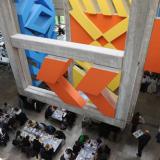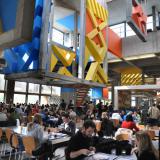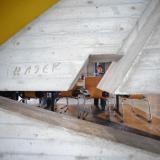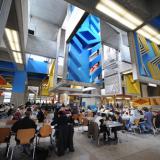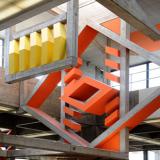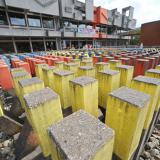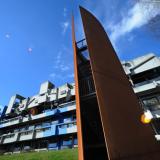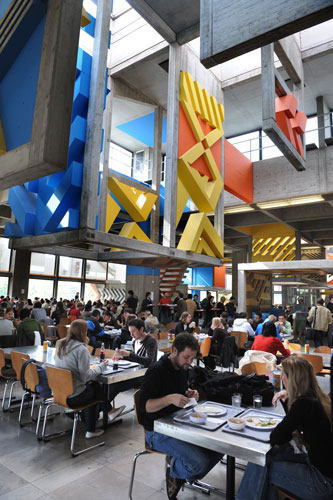 In addition to providing a wide selection of delicious meals, the Mensa in Saarbrücken is significant because of its distinctive architecture. Designed in 1966 by the Saarland architect Walter Schrempf with an interior space conceived in conjunction with the sculptor Otto Herbert Hajek, the Mensa building in Saarbrücken is an outstanding example of modern post-war architecture. The collaboration between these two creative spirits produced a building whose structure and interior space are of outstanding note. Schrempf and Hajek were interested in developing an architecture that created a direct and immediately tangible human environment. Colour and an appreciation of plasticity and three-dimensionality were exploited to combine the traditional artistic disciplines of painting and sculpture. Their aim was also to arrive at a modern form of architecture that was receptive to the technological age and that made use of new materials.
In addition to providing a wide selection of delicious meals, the Mensa in Saarbrücken is significant because of its distinctive architecture. Designed in 1966 by the Saarland architect Walter Schrempf with an interior space conceived in conjunction with the sculptor Otto Herbert Hajek, the Mensa building in Saarbrücken is an outstanding example of modern post-war architecture. The collaboration between these two creative spirits produced a building whose structure and interior space are of outstanding note. Schrempf and Hajek were interested in developing an architecture that created a direct and immediately tangible human environment. Colour and an appreciation of plasticity and three-dimensionality were exploited to combine the traditional artistic disciplines of painting and sculpture. Their aim was also to arrive at a modern form of architecture that was receptive to the technological age and that made use of new materials.
The result was a functional building that is simultaneously a sculptured space, the core of which is a monumental dining hall covering some 3600 square metres and providing seating for 1200 guests. Bare concrete contrasts with lively yellow, red and blue coloured surfaces. The effect the space has on the observer is determined by a series of modular nested geometric elements. Sculptured concrete elements divide the interior of the building into a variety of levels and subspaces. It is the building’s distinctive architecture in combination with these artistic elements that gives the space its distinguishing characteristics. The Saarbrücken Mensa building is a listed building.
Source: Anna Hofmann, in ‘Kunst im öffentlichen Raum’, 1999
Photos: Iris Maurer

 In addition to providing a wide selection of delicious meals, the Mensa in Saarbrücken is significant because of its distinctive architecture. Designed in 1966 by the Saarland architect Walter Schrempf with an interior space conceived in conjunction with the sculptor Otto Herbert Hajek, the Mensa building in Saarbrücken is an outstanding example of modern post-war architecture. The collaboration between these two creative spirits produced a building whose structure and interior space are of outstanding note. Schrempf and Hajek were interested in developing an architecture that created a direct and immediately tangible human environment. Colour and an appreciation of plasticity and three-dimensionality were exploited to combine the traditional artistic disciplines of painting and sculpture. Their aim was also to arrive at a modern form of architecture that was receptive to the technological age and that made use of new materials.
In addition to providing a wide selection of delicious meals, the Mensa in Saarbrücken is significant because of its distinctive architecture. Designed in 1966 by the Saarland architect Walter Schrempf with an interior space conceived in conjunction with the sculptor Otto Herbert Hajek, the Mensa building in Saarbrücken is an outstanding example of modern post-war architecture. The collaboration between these two creative spirits produced a building whose structure and interior space are of outstanding note. Schrempf and Hajek were interested in developing an architecture that created a direct and immediately tangible human environment. Colour and an appreciation of plasticity and three-dimensionality were exploited to combine the traditional artistic disciplines of painting and sculpture. Their aim was also to arrive at a modern form of architecture that was receptive to the technological age and that made use of new materials.